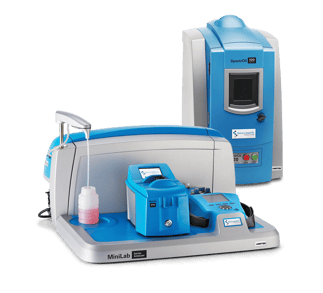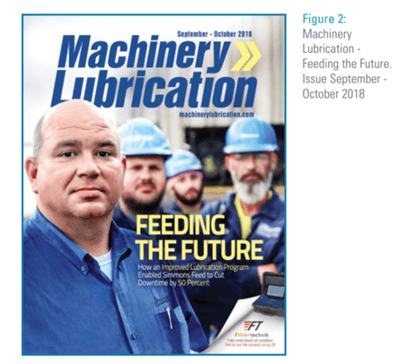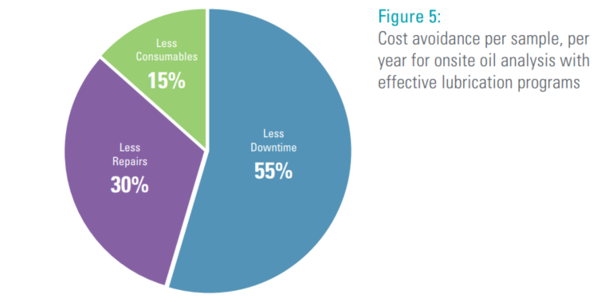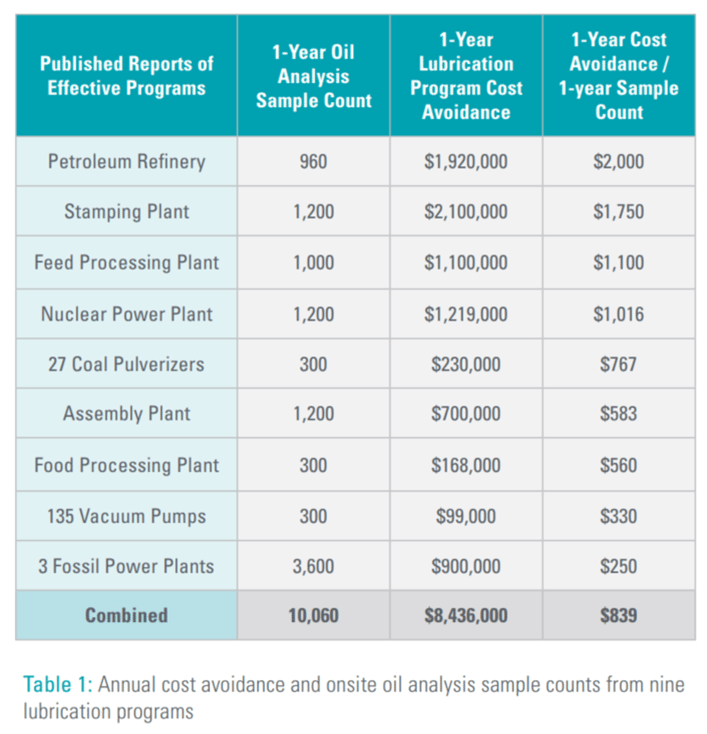Introduction
This article reports annual cost savings from several effective lubrication programs using onsite oil analysis. These published case histories cover various industries. These lubrication programs employ the following steps that differentiate effective lubrication programs with excellent cost avoidance from ineffective, low cost avoidance lubrication programs.
These eight steps distinguish effective lubrication programs from ineffective ones: 
- Sampling procedures – consistent periodic active zone lubricant sampling with observations of fluid levels and immediate vicinity.
- Condition-based oil changes – onsite oil analysis enables condition-based oil changes.
- Misapplication control – tagged sample ports, apparatus, transfer containers, compartments, and storage containers.
- Acceptance testing – bulk oil tested on delivery for viscosity, moisture, acid/base number and particle count.
- Contamination control – target cleanliness levels for particulate and water.
- Verification – retest prior to taking expensive maintenance action.
- Condition-based asset repair and overhaul – oil analysis guides maintenance practice.
- Alarm limits – warning thresholds and action thresholds are meaningful and validated.
In addition to the listed steps, each one of these successful programs has a secret ingredient. “The secret ingredient to success is passion. With it, a marginal technical program can succeed. Without it, a great technical program is destined for mediocrity or failure. Every successful oil analysis program I have observed has passionate technicians performing the work. And almost without exception, each includes some degree of onsite oil analysis. Can onsite oil analysis bring this secret ingredient of passion to your oil analysis program?”(1)
Industrial plant lubrication programs are organized to assure in-service lubricating and hydraulic fluids are kept clean, dry, and fit for use; these fluids are right for the applications; and they are filled to the correct levels. These programs can yield outstanding results. It is common for effective lubrication programs to report more than 700% return on investment with a two-month payback period.
How SFI identifies challenges and begins its effective lubrication program
One of nine examples where implementation of an effective lubrication program with onsite oil analysis paid off, with return on investment. is Simmons Feed Ingredients. (3) SFI is a family-owned and operated company that produces high-quality animal nutrition for pet food, aquaculture and livestock. In the 67 years since the construction of its first ingredient facility, SFI has continued to acquire additional operations and currently operates plants from Southwest City, Missouri to Quakertown, Pennsylvania.
Prior to committing to its lubrication-enabled reliability plan, the SFI Southwest City plant experienced consistent equipment failures. It could take over three quarters of the day to get the plant back up and running. The plant operated in a reactive mode, keeping spare parts in the storeroom to fix machines as necessary. If the facility didn’t have the parts, the machines would be down until the appropriate components arrived. During unscheduled downtime, perishable ingredients had to be sold to competitors at a reduced cost to avoid expiration. 
SFI Southwest City implemented an effective lubrication program including the eight steps outlined above. By improving its lubrication program and subsequently cutting downtime. SFI is now on the other side of the equation, allowing Simmons to buy perishable goods from its competitors.
SFI Southwest City addressed reactive maintenance by implementing the following improvements to its lubrication program:
Sampling procedures – written procedures assure consistent sampling and noted observations.
Condition-based oil changes – some oil has been in the sumps for 1,500 days and is still in good health.
Misapplication control – clearly marked, color coded sample ports, apparatus, transfer containers, dedicated oil compartments, and filter carts prevent cross-contamination issues.
Acceptance testing – the in-house oil analysis laboratory allows for fast analysis of incoming and in-service lubricants.
Contamination control – target cleanliness levels with new storage tanks enable the plant to keep oils cleaner and dryer.
Verification – SFI set up exception testing in the event that the samples demonstrated deficiencies and the lab provides a faster analysis of incoming and in-service lubricants.
Condition-based asset repair and overhaul – SFI concentrates on predictive and proactive maintenance rather than on reactive work. If technicians identify an issue, the new procedure requires employees to immediately create a work request. This system increases the efficiency of equipment repair and enables management to track and check specific replacement parts.
Alarm limits – Onsite oil analysis alarm limits are set based on this equipment operating in this environment. The company discontinued the lab’s standard one-size-fits-all approach to testing and developed written test slates for each sample from every equipment profile.
Because of its dedication to lubrication-enabled reliability, the Southwest City plant is now the flagship of reliability and success for Simmons Foods personnel from Southwest City, Missouri to Quakertown, Pennsylvania and an exemplar for competing industry manufacturers.
Published Reports from Effective Lubrication Programs in Various Industries
Simmons Feed Ingredients is the third of nine different published case histories reported herein. All nine examples report a very high return from implantation of an effective lubrication program. The totals for these nine effective lubrication programs are approximately 10,000 onsite oil analysis samples each year, reporting $8,436,000 cost avoidance. This totals $839 cost avoidance per sample per year for all nine lubrication programs.
The pie chart in Figure 5, proportions this overall cost savings per sample per year as follows: 55% from less downtime, 30% from less repairs and 15% from less consumables.

The nine published case histories are reported here and summarized in Table 1. Sorted from highest to lowest reported cost avoidance per sample per year, $2,000 to $250. Considering the very small cost to run each sample on a MiniLab, this table shows very high return on investment from all of these effective lubrication programs.

Notice that the lubrication program cost avoidance reported for each of these published case histories is conservative. Each reference only reports portions of the overall cost avoidance relevant to the respective publication scope.
Petroleum Refinery
This refinery initiated a world class lubrication program credited with reducing maintenance work orders by 1/3, from 995 to 674 failure related work orders. The published case histories show cumulative and sustained cost savings year after year, due to implementation of the effective lubrication program supported by onsite oil analysis.
Stamping Plant
This stamping plant lubrication program initially consolidated lubricants and addressed leakage. Onsite oil analysis detected and quantified progressing fatigue and shear failures in rocker mechanisms from two 1000 ton Hamilton Presses. Continued operation without immediate maintenance would have been catastrophic. Onsite oil analysis findings avoided danger to the press operators. Without oil analysis, problems like these are not known until the table drops. At that point, it takes several months to repair. These results allowed both presses to be repaired quickly. Press 16-3 took about three weeks to repair a broken rocker arm. The sheared stud on press 16-4 was repaired within 24 hours. Several months of lost production was avoided by detecting these hidden problems and planning and scheduling the repairs. Savings in each case is estimated at $50,000 in avoided maintenance and $1,000,000 in lost production.
Feed Processing Plant
This food processing plant experienced consistent equipment failure before implementing its effective lubrication program. It could take over three quarters of the day just getting the plant back up and running after a breakdown. The plant operated in a reactive mode, keeping spare parts in the storeroom to fix machines as necessary. If the facility didn’t have the parts, the machines would be down until the appropriate components arrived. During these unscheduled downtime intervals, perishable ingredients had to be sold to competitors at a reduced cost to avoid expiration. Now with the improved lubrication program, the plant achieved approximately $1.1 million cost avoidance due to 50% less downtime, fewer repairs, improved contamination control and lubricant consolidation. The facility implemented validated cautionary and critical planning for scheduling 85 percent of its work orders because employees can identify necessary replacement parts before the machines fail.
Nuclear Power Plant
In addition to the historic cost savings from its effective lubrication program, this nuclear power plant avoided a costly outage by immediately resampling and retesting with onsite oil analysis. Without onsite oil analysis products, the unit would have been taken offline while an investigation began. It would have taken another three days to get the results of the second sample and $270,000 per day is expensive downtime. That doesn’t include the cost of new oil, disposal of the used oil, and man-hours of labor. If the first sample had been accurate, then the contaminated oil would have been circulating through the bearings for three or more days. This would likely have caused more damage and longer downtime. A conservative estimate for total cost avoidance: three days minimum downtime $810,000 + disposal of 1,000 gallons of oil $350,000 + new oil $20,700 + labor for 24-hour coverage $36,400 = $1,219,100.
27 Coal Pulverizers
This power plant implemented onsite oil analysis along with other lubrication program initiatives to perform condition-based oil changes, repairs, and overhauls for its 27 similar coal pulverizers. Maintenance and repair histories for these pulverizers were studied and trended. Before this, the coal pulverizers followed scheduled maintenance and overhaul. Typical overhaul of the main bearing cost $10,000. Unscheduled breakdown failures occurred at a rate of three or four per year. Condition-based repair and overhaul was implemented. Moisture and lubricant degradation indications above the 80th percentile received oil changes and seals were replaced as needed. Highest wear debris indications were torn down for repair and overhaul. The number of breakdowns dropped to less than one per year and the amount spent on overhaul was also reduced. The27 coal pulverizers achieved a total cost savings of $230,000 in the first year after these practices were implemented.
Assembly Plant
This truck and bus assembly plant implemented onsite oil analysis, taking ownership onsite of its own lubrication program. Lubrication quality improved, machine wear reduced and oil drain intervals extended. The plant’s oil analysis program enabled the team to assure proper lubrication and contamination control and provides them with a clear understanding of the condition of the machines. Interestingly, this was accomplished while saving money on the lubricants, disposal and sampling. With managerial support for training, improvements in storage and handling, and continuous improvement in lubrication procedures and practices, this focus on lubrication improvements can deliver strong financial rewards, 700% return on investment with a three-month payback period.
Conclusion from All Nine Lubrication Programs
Combined one-year sample count for all nine lubrication programs is 10,060 samples tested with onsite oil analysis. Combined lubrication programs cost savings was $8,436,000. On average, the effective lubrication programs saved $839.00 for every sample tested.
Refinery, assembly, stamping, power, food and beverage and electronic component manufacturing industries are diverse businesses. However, all of them depend on pumps, motors, compressors, gearboxes, and other rotating, reciprocating and articulating machinery to produce products. The reliability programs in these plant sites focused on lubrication of production machinery, resulting in sustained reliability improvements year after year.
In these nine lubrication programs, motivated technicians used onsite oil analysis within their respective successful lubrication programs. These individuals and their lubrication programs have been recognized by their corporations and by their peers as evidenced by the publications cited in footnotes below. An average savings of more than $800.00 per sample for more than 10,000 samples tested within these nine lubrication programs deserves recognition. These case history publications show how to improve reliability by building successful lubrication programs within plant sites and across corporations.



